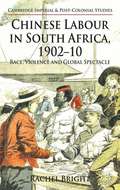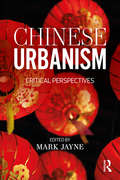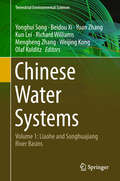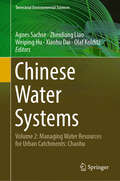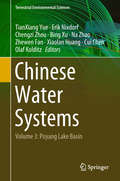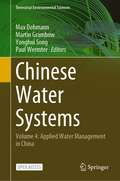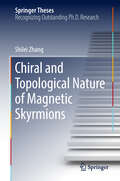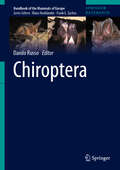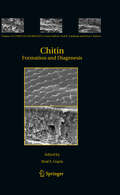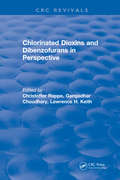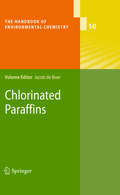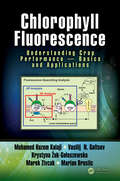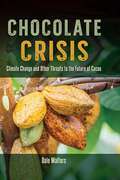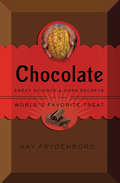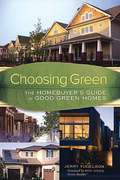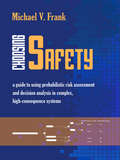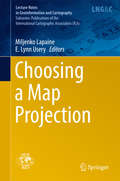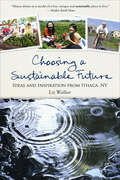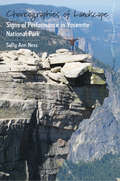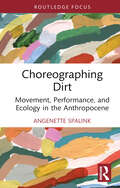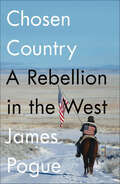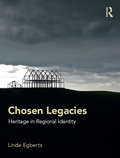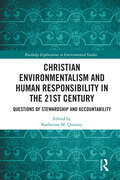- Table View
- List View
Chinese Labour in South Africa, 1902-10
by Rachel K. BrightThis book explores the decision of the British Empire to import Chinese labour to southern Africa despite the already tense racial situation in the region. It enables a clearer understanding of racial and political developments in southern Africa during the reconstruction period and places localised issues within a wider historiography.
Chinese Urbanism: Critical Perspectives
by Mark JayneThis book provides a definitive overview of contemporary developments in our understanding of urban life in China. Multidisciplinary perspectives outline the most significant critical, theoretical, methodological and empirical developments in our appreciation of Chinese cities in the context of an increasingly globalized world. Each chapter includes reviews and appraisals of past and current theoretical development and embarks on innovative theoretical directions relating to Marxist, feminist, post-structural, post-colonial and ‘more-than-representational’ thinking. The book provides an in-depth insight into urban change and considers in what ways theoretical engagement with Chinese cities contributes to our understanding of ‘global urbanism’. Chapters explore how new critical perspectives on economic, political, social, spatial, emotional, embodied and affective practices add value to our understanding of urban life in, and beyond, China. Chinese Urbanism offers valuable insights which will be of interest to students and scholars alike working in geography, urban studies, Asian studies, economics, political studies and beyond.
Chinese Water Systems: Volume 1: Liaohe And Songhuajiang River Basins (Terrestrial Environmental Sciences Ser.)
by Richard Williams Olaf Kolditz Beidou Xi Yonghui Song Yuan Zhang Kun Lei Mengheng Zhang Weijing KongThis book describes the huge efforts by the Chinese Government concerning the restoration and future sustainable management of Chinese water systems. It presents the results of a Sino-European joint project concerning the Songhuajiang-Liaohe River Basin (SLRB) in Northeast China conducted by the Chinese Research Academy of Environmental Sciences (CRAES), the Helmholtz Centre for Environmental Research - UFZ, Germany, and the Natural Environment Research Council as represented by the Centre for Ecology and Hydrology (CEH), UK. The book explains in great detail the development of risk assessment and corresponding management methods for (i) controlling water pollution, (ii) assessing river health and ecological restoration options, (iii) characterizing persistent organic pollutants (POPs), and (iv) protecting fragile groundwater resources. It also describes the implemented demonstration sites of SLRB during the project course as well as lessons learnt on efficient project management and the dissemination of knowledge and technologies.
Chinese Water Systems: Volume 3: Poyang Lake Basin (Terrestrial Environmental Sciences Ser.)
by Weiping Hu Olaf Kolditz Agnes Sachse Zhenliang Liao Xiaohu DaiThis volume addresses the latest results of the Major Water Program of the Chinese Government which aims at the restoration of polluted water environments and sustainable management of water resources in China. It specifically summarizes the results of the BMBF-CLIENT project “Management of Water Resources in Urban Catchments” and the related MoST project “Key Technologies and Management Modes for the Water Environmental Rehabilitation of a Lake City from the Catchment Viewpoint” in Chaohu. The project is conducted by the Helmholtz-Centre for Environmental Research UFZ, Technische Universität Dresden, German and Chinese companies (WISUTEC, AMC, bbe Moldaenke, itwh, OpenGeoSys e.V., HC System and EWaters) in close cooperation with Tongji University, Nanjing Institute of Geography and Limnology of Academy of Sciences, Institute for Hydrobiology of the Chinese Academy of Sciences and the Chaohu Lake Management Authority. The book explains the development of concepts and solutions for sustained water quality improvement in Chaohu, combining urban water resource management, decentralized sanitation solutions, methods in water quality assurance, environmental information systems and groundwater modeling.
Chinese Water Systems: Volume 3: Poyang Lake Basin (Terrestrial Environmental Sciences)
by Olaf Kolditz Bing Xu Erik Nixdorf TianXiang Yue Chengzi Zhou Na Zhao Zhewen Fan Xiaolan Huang Cui ChenThis volume of the Chinese Water Systems subseries offers up-to-date and comprehensive information on various aspects of the Poyang Lake, the largest freshwater lake in China. Following a detailed introduction of the lake basin, the respective chapters present the findings of studies examining surface and subsurface hydrology, relationships between plant ecology and pollution of the wetlands, changes of land cover as well as the development of modern computational approaches to create Environmental Information Systems for water management. Moreover, the results are supplemented by a wealth of numerical calculations, tables, figures and photographs to make the research results more tangible. Closing with concise information on the “Research Centre for Environmental Information Science” (RCEIS), the book offers a valuable guide for researchers, teachers and professionals working in the areas of water environment, water security and ecological restoration. The projects have been supported by the Sino-German Centre for Science Promotion, the Helmholtz Association and the Chinese Academy of Sciences.
Chinese Water Systems: Volume 4: Applied Water Management in China (Terrestrial Environmental Sciences)
by Martin Grambow Yonghui Song Max Dohmann Paul WermterThis open-access book addresses latest Sino-German results of the joint research efforts within Major Water Program of the Chinese Government supported by German research funding. The Major Water Program aims at the restoration of polluted water environments and sustainable management of water resources in China. The joint BMBF-CLIENT project SINOWATER deals with three most significant and strongest polluted Chinese waters, the river Liao and the Dian-lake as well as Tai-lake in the area of the metropolises Shenyang, Kunming and Suzhou, respectively. The project was conducted by the Research Institute for Water and Waste Management at RWTH Aachen (FiW) e.V., Bavarian State Ministry of the Environment and Consumer Protection, Technical University of Munich, RWTH Aachen University, German and Chinese companies (Martin Membrane Systems AG, Steinhardt GmbH Wassertechnik, GuHong, JT-elektronik, bluemetric, Huawang Water, EVU Group, Atemis GmbH, i+f process GmbH) in close cooperation with Chinese Academy of Environmental Sciences, Tongji University, and the Dianchi Lake Management Authorities. Overall, the joint Sino-German research project SINOWATER provided solutions for the improvement of the water quality in the mentioned water bodies as well as development and optimization of Good Water Governance. These objectives could be achieved through the implementation of innovative German water technologies and the optimization of water management elements in the fields of industrial and municipal wastewater treatment as well as river and shallow lake management.
Chiral and Topological Nature of Magnetic Skyrmions (Springer Theses)
by Shilei ZhangThis book focuses on the characterisation of the chiral and topological nature of magnetic skyrmions in noncentrosymmetric helimagnets. In these materials, the skyrmion lattice phase appears as a long-range-ordered, close-packed grid of nearly millimetre-level correlation length, while the size of a single skyrmion is 3–100 nm. This is a very challenging range of length scales (spanning 5 orders of magnitude from tens of nm to mm) for magnetic characterisation techniques, and, to date, extensive information on this fascinating, magnetically ordered state has remained elusive. In response, this work develops novel resonant elastic x-ray scattering (REXS) techniques, which allow the magnetic structure, including the long-range order and domain formation, as well as microscopic skyrmion parameters, to be measured across the full range of length scales. Most importantly, using circular dichroism in REXS, the internal structure of a given skyrmion, the topological winding number, and the skyrmion helicity angle can all be unambiguously determined. These new techniques are applicable to many materials systems, and allow us to retrieve information on modulated spin structures, multiferroic order, spin-density-waves, and other forms of topological magnetic order.
Chirality, Magnetism and Magnetoelectricity: Separate Phenomena and Joint Effects in Metamaterial Structures (Topics in Applied Physics #138)
by Eugene KamenetskiiThis book discusses theoretical and experimental advances in metamaterial structures, which are of fundamental importance to many applications in microwave and optical-wave physics and materials science. Metamaterial structures exhibit time-reversal and space-inversion symmetry breaking due to the effects of magnetism and chirality. The book addresses the characteristic properties of various symmetry breaking processes by studying field-matter interaction with use of conventional electromagnetic waves and novel types of engineered fields: twisted-photon fields, toroidal fields, and magnetoelectric fields. In a system with a combined effect of simultaneous breaking of space and time inversion symmetries, one observes the magnetochiral effect. Another similar phenomenon featuring space-time inversion symmetries is related to use of magnetoelectric materials. Cross-coupling of the electric and magnetic components in these material structures, leading to the appearance of new magnetic modes with an electric excitation channel – electromagnons and skyrmions – has resulted in a wealth of strong optical effects such as directional dichroism, magnetochiral dichroism, and rotatory power of the fields. This book contains multifaceted contributions from international leading experts and covers the essential aspects of symmetry-breaking effects, including theory, modeling and design, proven and potential applications in practical devices, fabrication, characterization and measurement. It is ideally suited as an introduction and basic reference work for researchers and graduate students entering this field.
Chiroptera (Handbook of the Mammals of Europe)
by Danilo RussoPreliminaryThis volume provides comprehensive overviews of each European bat species’ biology including palaeontology, physiology, genetics, reproduction and development, ecology, habitat, diet, mortality and age determination. Their economic significance and management, as well as future challenges for research and conservation are also addressed. Each chapter includes a distribution map, a photograph of the animal and key literature. This authoritative volume of the Handbook of the Mammals of Europe is a timely and detailed compilation of all European bats and will appeal to academics, students and professionals in mammal research.
Chitin: Formation and Diagenesis (Topics in Geobiology #34)
by Neal S. GuptaThere are several books on properties of chitin and associated biomolecules and their biochemical significance. However, the present volume deals with a wide variety of biogeochemical and organic geochemical aspects of this vital macromolecule written by leading authors and experts in the field. Each chapter is carefully peer reviewed and is an updated account of recent research in isotopic, nanostructural, biochemical, microstructural, geochemical, paleontological and experimental aspects of chitin formation, distribution and preservation in the environment and earth history.
Chlorinated Dioxins and Dibenzofurans in Perspective
by Christoffer RappeThis volume was developed from the proceedings of a symposium held in Miami Beach, at the 189th National Meeting of the American Chemical Society.It is the result of the combined efforts of many experts whose efforts have advanced our knowledge of the production, analysis, distribution, effects and control of chlorinated dioxins, dibenzofurans and related compounds.This is the third in a series of publications originating from current technology presented at national meetings of the American Chemical Society. Using this forum as a catalyst, researchers from all over the world came together to present and discuss their data and plan future work in this rapidly developing and sometimes highly emotional technical area.
Chlorinated Paraffins (The Handbook of Environmental Chemistry #10)
by C. De BoerChlorinated paraffins are one of the last classes of chlorinated compounds that are still being produced worldwide and used in high quantities in many applications. They are particularly used in cutting oils in the metal industry, but also as lubricants, plasticizers, flame retardants and as additives in adhesives, rubber, paints and sealants. This volume covers the state-of-the-art of methods for the synthesis and analysis of chlorinated paraffins. Experts in the field provide an overview of their worldwide occurrence and utilization and describe their toxicological properties. International regulations and production volumes are presented as well as an example of a risk assessment study that was carried out in Japan. This book is a valuable and comprehensive source of information for environmental scientists interested in the occurrence and toxicology of chlorinated paraffins and for authorities and producers.
Chlorophyll Fluorescence: Understanding Crop Performance — Basics and Applications
by Mohamed H. Kalaji Vasilij N. Goltsev Krystyna Żuk-Gołaszewska Marek Zivcak Marian BresticChlorophyll a fluorescence is a tool for evaluating plant responses to stress conditions. Fluorescence can be used in plant phenotyping and breeding programs to monitor biotic and abiotic stresses including mineral deficiencies, soil salinity, and pathogenic diseases. Chlorophyll Fluorescence: Understanding Crop Performance — Basics and Applications reviews a diversity of instruments available for recording and analyzing different types of light signals from plants and addresses the use of chlorophyll a fluorescence in research on plants and other photosynthesizing organisms, such as algae and cyanobacteria. This book characterizes the phenomenon of chlorophyll a fluorescence, describes the methods for its measurement, and demonstrates — using selected examples — the applicability of these methods to research the response of the photosynthetic apparatus and plant tolerance to unfavorable environmental conditions. In addition, chapters cover a general background on photosynthesis, analysis of delayed fluorescence, and the pulse amplitude modulated (PAM) technique. The book is addressed to a wide range of professionals in photosynthesis research and scientists from other areas of plant sciences.
Chocolate Crisis: Climate Change and Other Threats to the Future of Cacao
by Dale WaltersChocolate is the center of a massive global industry worth billions of dollars annually, yet its future in our modern world is currently under threat. In Chocolate Crisis, Dale Walters discusses the problems posed by plant diseases, pests, and climate change, looking at what these mean for the survival of the cacao tree.Walters takes readers to the origins of the cacao tree in the Amazon basin of South America, describing how ancient cultures used the beans produced by the plant, and follows the rise of chocolate as an international commodity over many centuries. He explains that most cacao is now grown on small family farms in Latin America, West Africa, and Indonesia, and that the crop is not easy to make a living from. Diseases such as frosty pod rot, witches’ broom, and swollen shoot, along with pests such as sap-sucking capsids, cocoa pod borers, and termites, cause substantial losses every year. Most alarmingly, cacao growers are beginning to experience the accelerating effects of global warming and deforestation. Projections suggest that cultivation in many of the world’s traditional cacao-growing regions might soon become impossible.Providing an up-to-date picture of the state of the cacao bean today, this book also includes a look at complex issues such as farmer poverty and child labor, and examines options for sustainable production amid a changing climate. Walters shows that the industry must tackle these problems in order to save this global cultural staple and to protect the people who make their livelihoods from producing it.
Chocolate: Sweet Science & Dark Secrets of the World's Favorite Treat
by Kay FrydenborgChocolate hits all the right sweet--and bitter--notes: cutting-edge genetic science whisked in with a strong social conscience, history, and culture yield one thought-provoking look into one of the world's most popular foods. Readers who savored Chew on This and Food, Inc. and lovers of chocolate will relish this fascinating read.
Chomp: A Shark Romp
by Michael PaulDive in to the depths of the ocean to discover different species of sharks in this nonfiction picture book with simple text and illustrations.Many different kinds of sharks are swimming below the ocean's surface.Some sharks are gentle, and some sharks are fierce. Some are awake in the day, and some are awake at night. Some eat almost anything, and some are very picky.You may not be able to visit their watery world, but you can always visit them up close at the aquarium.Simple text and bold illustrations take young explorers on a deep dive through the ocean full of sharks.Don't Miss More from Michael Paul in Roar: A Dinosaur Tour!
Choosing Green: The Homebuyer's Guide to Good Green Homes
by Jerry YudelsonDrawing from the expertise of dozens of homebuilders, government officials, and green home experts, Choosing Green deftly takes the reader through these considerations with easy-to-use tables, charts, maps, score sheets, and checklists. The book includes a glossary of green building terms, an extensive resource section, and a list of homebuilders, green rating programs, and financial incentives. This comprehensive book provides home buyers with every thing they will need to make a successful search for their own green home.
Choosing Safety: A Guide to Using Probabilistic Risk Assessment and Decision Analysis in Complex, High-Consequence Systems
by Michael V. FrankThe technological age has seen a range of catastrophic and preventable failures, often as a result of decisions that did not appropriately consider safety as a factor in design and engineering. Through more than a dozen practical examples from the author‘s experience in nuclear power, aerospace, and other potentially hazardous facilities, Choosing Safety is the first book to bring together probabilistic risk assessment and decision analysis using real case studies. For managers, project leaders, engineers, scientists, and interested students, Michael V. Frank focuses on methods for making logical decisions about complex engineered systems and products in which safety is a key factor in design - and where failure can cause great harm, injury, or death.
Choosing a Map Projection (Lecture Notes in Geoinformation and Cartography)
by Miljenko Lapaine E. Lynn UseryThis book offers a much-needed critical approach to the intelligent use of the wide variety of map projections that are rapidly and inexpensively available today. It also discusses the distortions that are immanent in any map projection. A well-chosen map projection is one in which extreme distortions are smaller than those in any other projection used to map the same area and in which the map properties match its purpose. Written by leading experts in the field, including W. Tobler, F. C. Kessler, S. E. Battersby, M. P. Finn, K. C. Clarke, V. S. Tikunov, H. Hargitai, B. Jenny and N. Frančula. This book is designed for use by laymen. The book editors are M. Lapaine and E. L. Usery, Chair and Vice-Chair, respectively, of the ICA Commission on Map Projections for the period 2011-2015.
Choosing a Sustainable Future: Ideas and Inspiration from Ithaca, NY
by Liz WalkerA small city's big vision that can help transform your own community. We all want a sustainable future, but what does it look like, and how do we get there? In Ithaca, NY a new culture is blossoming-one that values cooperation, local production, environmental stewardship, social justice andcreativity. Ithaca is showing the way to meet the challenges of the day with a wide variety of practical, real-world solutions.Filled with inspiring examples, Choosing a Sustainable Future provides readers with a remarkable sense of possibility. Explore Ithaca's:bustling, vibrant farmers markets, overflowing with fresh, local produceaward-winning community credit union that triples the savings of low-income peopleflagship college sustainability programspioneering alternative transportation programs, such as Ithaca Carshareinnovative efforts by coalitions of local business, university, government and activists to create transformation in areas as diverse as green building, city planning, health and wellness, and honoring cultural diversity.Taken together, these examples of citizen engagement are a taste of what life could be like in a sustainable city of the future. In a time of overwhelming economic, social and environmental crises, Choosing aSustainable Future provides a quiet, authoritative voice of hope.
Choreographies of Landscape: Signs of Performance in Yosemite National Park
by Sally Ann NessAs an international ecotourism destination, Yosemite National Park welcomes millions of climbers, sightseers, and other visitors from around the world annually, all of whom are afforded dramatic experiences of the natural world. This original and cross-disciplinary book offers an ethnographic and performative study of Yosemite visitors in order to understand human connection with and within natural landscapes. By grounding a novel "eco-semiotic" analysis in the lived reality of parkgoers, it forges surprising connections, assembling a collective account that will be of interest to disciplines ranging from performance studies to cultural geography.
Choreographing Dirt: Movement, Performance, and Ecology in the Anthropocene (Routledge Studies in Theatre, Ecology, and Performance)
by Angenette SpalinkThis book is an innovative study that places performance and dance studies in conversation with ecology by exploring the significance of dirt in performance. Focusing on a range of 20th- and 21st-century performances that include modern dance, dance-theatre, Butoh, and everyday life, this book demonstrates how the choreography of dirt makes biological, geographical, and cultural meaning, what the author terms "biogeocultography". Whether it’s the Foundling Father digging into the earth’s strata in Suzan-Lori Park’s The America Play (1994), peat hurling through the air in Pina Bausch’s The Rite of Spring (1975), dancers frantically shovelling out fistfuls of dirt in Eveoke Dance Theatre’s Las Mariposas (2010), or Butoh performers dancing with fungi in Iván-Daniel Espinosa’s Messengers Divinos (2018), each example shows how the incorporation of dirt can reveal micro-level interactions between species – like the interplay between microscopic skin bacteria and soil protozoa – and macro-level interactions – like the transformation of peat to a greenhouse gas. By demonstrating the stakes of moving dirt, this book posits that performance can operate as a space to grapple with the multifaceted ecological dilemmas of the Anthropocene. This book will be of broad interest to both practitioners and researchers in theatre, performance studies, dance, ecocriticism, and the environmental humanities.
Chosen Country: A Rebellion in the West
by James Pogue"Whoever you are, whatever side you’re on, if you care about the American west and what’s happening to it, read this book."—Caroline Fraser, Pulitzer Prize-winning author of Prairie FiresAn extraordinary inside look at America’s militia movement that shows a country at the crossroads of class, culture, and insurrection.In a remote corner of Oregon, James Pogue found himself at the heart of a rebellion. Granted unmatched access by Ammon Bundy to the armed occupation of the Malheur National Wildlife Refuge, Pogue met ranchers and militiamen ready to die fighting the federal government.He witnessed the fallout of communities riven by politics and the danger (and allure) of uncompromising religious belief. The occupation ended in the shooting death of one rancher, the imprisonment of dozens more, and a firestorm over the role of government that engulfed national headlines. In a raw and restless narrative that roams the same wild terrain as his literary forebears Edward Abbey and Hunter S. Thompson, Pogue's Chosen Country examines the underpinnings of this rural uprising and struggles to reconcile diverging ideas of freedom, tracing a cultural fault line that spans the nation.
Chosen Legacies: Heritage in Regional Identity
by Linde EgbertsThe urge for regional identity has not declined in the process of globalization. Rather, heritage is used to develop regional distinctiveness and to charge identities with a past. Particularly helpful for this aim are creation stories, Golden Ages or recent, shared traumas. Some themes such as the Roman era or the Second World War appear easier to appropriate than, for example, prehistory. This book assesses the role of heritage in the construction of regional identities in Western Europe. It contains case studies on early medieval heritage in Alsace and Euregio-Meuse Rhine, industrial heritage in the German Ruhr area and competing memories in the Arnhem-Nijmegen region in the Netherlands. It presents new insights into the process of heritage production on a regional level in relationship to processes of identity construction. The theoretical analysis of "heritage" and "regional identity" is innovative as these concepts were hardly analysed in relation to each other before. This book also offers insights into policy, tourism, spatial development and regional development to policymakers, politicians, designers and professionals in the heritage and tourism industries.
Christian Environmentalism and Human Responsibility in the 21st Century: Questions of Stewardship and Accountability (Routledge Explorations in Environmental Studies)
by Katherine M. QuinseyChristian Environmentalism and Human Responsibility in the 21st Century comprises original scholarly essays and creative works exploring the implications of Christian environmentalism through literary and cultural criticism and creative reflection. The volume draws on a flourishing recent body of Christian ecocriticism and environmental activity, incorporating both practical ethics and environmental spirituality, but with particular emphasis on the notion of human responsibility. It discusses responsibility in its dual sense, as both the recognized cause of environmental destruction and the ethical imperative of accountability to the nonhuman environment. The book crosses boundaries between traditional scholarly and creative reflection through a global range of topics: African oral tradition, Ohio artists off the grid, immigrant self-metaphors of land and sea, iconic writers from Milton to O’Connor to Atwood, and Indigenous Canadian models for listening to the nonhuman Mother of us all. In its incorporation of academic and creative pieces from scholars and creative artists across North America, this volume shows how environmental work of its nature and necessity crosses traditional academic and community boundaries. In both form and orientation, this collection speaks to the most urgent intellectual, physical, social, and spiritual needs of the present day. This book will appeal to scholars, researchers, and upper-level students interested in the relationship between religion and environment, ethics, animal welfare, poetry, memoir, and post-secularism.
